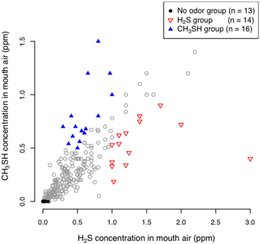Research Abstract
硫化水素およびメチルメルカプタンの高産生に関連する口腔常在フローラ
Discrimination of the oral microbiota associated with high hydrogen sulfide and methyl mercaptan production
2012年1月9日 Scientific Reports 2 : 215 doi: 10.1038/srep00215

多くの口臭患者では、呼気中から多量の硫化水素(H2S)とメチルメルカプタン(CH3SH)が検出される。我々は、CH3SH/H2S比が異常な値(硫化水素高産生群、n = 14;メチルメルカプタン高産生群、n = 16)を示す重度口臭患者30人と口臭がほとんど認められない13人の被験者について、16S rRNA遺伝子を利用したバーコードパイロシーケンス法を用いて唾液中の細菌構成の解析を行った。細菌群集間の系統学的距離を評価するUniFracを用いた解析から、同じ口臭群でもH2S高産生群とCH3SH高産生群では口腔フローラが異なっていることが示された。H2S高産生群では、他の2群に比べ、ナイセリア属(Neisseria)、フゾバクテリウム属(Fusobacterium)、ポルフィロモナス属(Porphyromonas)およびSR1の割合が特徴的に高い一方で、CH3SH高産生群では、プレボテラ属(Prevotella)、ベイヨネラ属(Veillonella)、アトポビウム属(Atopobium)、メガスフェラ属(Megasphaera)、およびセレノモナス属(Selenomonas)の割合が高かった。我々の結果は、口腔におけるH2SおよびCH3SHの高産生にはそれぞれ特有の常在細菌グループが関与することを示唆している。
- 九州大学 歯学部
- 福岡歯科大学 総合歯科学講座
- 日本大学歯学部
Both hydrogen sulfide (H2S) and methyl mercaptan (CH3SH) are frequently detected in large amounts in malodorous mouth air. We investigated the bacterial composition of saliva of 30 subjects with severe oral malodor exhibiting extreme CH3SH/H2S ratios (high H2S but low CH3SH concentrations, n = 14; high CH3SH but low H2S concentrations, n = 16) and 13 subjects without malodor, using barcoded pyrosequencing analysis of the 16S rRNA gene. Phylogenetic community analysis with the UniFrac distance metric revealed a distinct bacterial community structure in each malodor group. The H2S group showed higher proportions of the genera Neisseria, Fusobacterium, Porphyromonas and SR1 than the other two groups, whereas the CH3SH group had higher proportions of the genera Prevotella, Veillonella, Atopobium, Megasphaera, and Selenomonas. Our results suggested that distinct bacterial populations in the oral microbiota are involved in production of high levels of H2S and CH3SH in the oral cavity.

